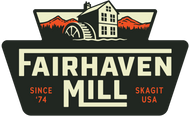Using alternative flour instead of traditional flour can open a world of diverse and exciting possibilities in baking and cooking. Whether it's due to dietary restrictions, health concerns, or a desire to explore new flavors, alternative flours offer unique tastes, textures, and nutritional benefits! When baking with alternative flours, it's essential to be aware of their unique characteristics and how they interact with other ingredients.
One thing to keep in mind is wheat flour provides higher protein content than alternative flour, so it is important to rely on leaveners and binders to help mimic the wheat flour makeup. Binders like xanthan gum or guar gum are often added to replace the binding properties of gluten.
Wheat flour relies on 2 major protein components: Glutenin and Gliadin
- Glutenin: Responsible for strength and elasticity of dough. This creates the bounciness of dough
- Gliadin: Provides ability to stretch and rise during baking
Once liquid is introduced, the proteins become active and the proteins begin unwinding and linking with each other to form “a network of strong elastic chains called gluten” according to Okonomi Kitchen.
So, when baking with gluten-free flour as opposed to wheat flour, you lose the binding capabilities, structure, and the bakes ability to rise. Adjusting the liquid content, using flavorful ingredients, and being patient with experimentation can lead to delightful gluten-free treats with amazing tastes and textures! Whether you have specific dietary needs or simply want to explore new culinary horizons, alternative flours offer a world of exciting baking possibilities!
Alternative Flour Baking Tips:
Measure accurately: A kitchen scale should be your best friend! Gluten-free baking is sensitive to measurements, so use measuring cups and spoons specifically designed for dry and wet ingredients. Accurate measurements ensure the right balance of ingredients.
Add binders and thickeners: Incorporate binding agents like xanthan gum or guar gum to improve the texture and structure of your baked goods. These ingredients help mimic the elasticity that gluten provides.
Increase liquid content: Gluten-free flour tends to absorb more liquid than regular flour. Be prepared to increase the liquid content in your recipes, such as adding extra water, milk, or other liquids.
Add moisture-rich ingredients: Incorporate ingredients that add moisture to your baked goods, like applesauce, mashed bananas, or yogurt. This helps prevent the final product from being dry or crumbly.
Don't overmix the batter: When working with gluten-free batters, avoid overmixing, as this can lead to a gummy or dense texture. Mix just until all the ingredients are combined.
Let the batter rest: Just like traditional baking, let your batter rest! Allow the batter to rest for a few minutes before baking. This resting time helps the flours hydrate properly, leading to a better texture in the finished product.
Experiment with different flours: Don't be afraid to experiment with various gluten-free flours and flour combinations. Different flours have distinct flavors and textures, so trying out different combinations can yield interesting results.
Use parchment paper or non-stick pans: Gluten-free baked goods can be stickier than regular ones. To avoid sticking, line your baking pans with parchment paper or use non-stick baking pans.
Treat your gluten-free (and wheat) dough like a fresh product: It is recommended to purchase in smaller quantities and store in a cool/dry place like your fridge/freezer. Freeze whatever you won’t eat in a couple of days.
Check for cross-contamination: If you have celiac disease or severe gluten sensitivity, make sure to use separate utensils, bowls, and equipment that haven't come into contact with gluten-containing ingredients. Cross-contamination can still trigger reactions even with gluten-free ingredients.
Bake at the right temperature and time: Gluten-free recipes may require slightly different baking times and temperatures than regular recipes. Keep a close eye on your baked goods and use a toothpick or cake tester to check for doneness.
Be patient and persistent: Gluten-free baking may require some trial and error to get your desired results. Don't get discouraged if your first attempt isn't perfect. With practice, you'll become more familiar with gluten-free baking techniques. Keep reading to learn how to troubleshoot any problems that may occur when using alternative flours. See below for some trouble shooting tips!
Trouble Shooting Tips
Remember, practice makes perfect, so don't be afraid to experiment and adjust your recipes as needed. Enjoy the process and the delicious gluten-free treats you create!
If my dough/bake is….
Sticky: This means that there is too much liquid in the dough, and the best way to fix it with wheat flour is to add more gluten-free flour.
Gummy in the Middle: With gluten-free baking the most common reason for being gummy in the middle is because it didn’t bake long enough. Also, let the bake rest for 10-15 minutes, so all the ingredients can absorb each other.
Crumbly: This means that you didn’t use a binder or enough of a binder in the flour blend. Gluten = glue that holds bakes together so because of this you need to add binders like xanthan gum, guar gum, or psyllium husk.
Too Dense: This means that not enough liquid was added. It is highly recommended to weigh ingredients accurately. One scooped cut of gluten-free flour and one cup of water will have different weights.
Happy Baking!
- The Fairhaven Mill Team




